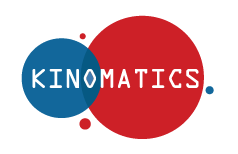What is Kinomatics?
The Kinomatics Project collects, explores, analyses and represents data about the creative industries. Our research is collaborative and interdisciplinary. Our current focus is on the spatial and temporal dimensions of international film flow and the location of Australian live music gigs.
Kinomatics is derived from the word Kinematics; the study of the geometry of motion, and Kino; the term meaning cinema in many countries. Kinomatics is therefore the study of the industrial geometry of motion pictures. The focus of Kinomatics has been extended further in our research to mean the study of the industrial geometry of culture.
Big Cinema Data
The Kinomatics Project is one of the first ‘big data’ studies of contemporary global cultural diffusion.
Its examination of the spatial and temporal dimensions of international film flow rests on a large dataset of showtime information comprising more than 120 million records that describe every film screening in 48 countries over a 12-month period as well as additional aggregated box-office data. Through further integrating different types of data (demographic data, social media data, technical infrastructure data, economic and financial data and climatic data for example) this project will explore the value of an ‘expanded’ approach to cultural data, rather than ‘big data’ per se. Outcomes from the project will be of significant interest to both film producers and distributors with spatial and network relationships being determined from a variety of geographic, social and economic factors.
Through exploration of this dataset, The Kinomatics Project aims to develop, test, and document best-practice models for working with big cultural data. It does this in three ways:
- Through explicitly understanding the cinema as comprising interdependent, overlapping, uneven networks of institutional, social and commercial practices
- Through the collation, organization and analysis of an international (48 countries) and consistent showtime dataset comprising approximately 120 million records per year.
- Through the further expansion of this dataset with associated information such as financial, spatial and demographic data.
Background
To date digital cinema research has been undertaken through of a series of initiatives produced “from below” (Maltby et al). This preference for working with local datasets is consistent with recent methodological breakthroughs in cinema historiography sometimes known as the New Cinema History.
Without exception the existing datasets that form the empirical basis for digital cinema research have occurred at the national or sub-national level. Cinema datasets have been generated for scholarly research projects focussed on (and not limited to): London (Christie), the Netherlands (Dibbets), Ghent (Biltereyst et al), Antwerp (Meers et al), Australia (Maltby et al; Verhoeven et al), Scotland (Hopwood et al) and North Carolina (Robert C. Allen). Each of these datasets were developed independently to solve specific research problems and they are not technically or semantically compatible. The prospect of interoperating these data collections remains a tantalising but near impossible challenge with few options for resourcing an undertaking of this magnitude.
Whilst the proliferation of these digital case studies has produced a great deal of methodological innovation in Cinema Studies, this disjointed approach has also resulted in a significant deficit in our understanding of the global nature of the cinema. These distributed computational platforms are not yet capable of addressing the global, elastic, and networked nature of the contemporary international film industry currently producing and exploiting huge quantities and varieties of data.
Aims
The Kinomatics Project is based on the premise that films can be understood as cultural goods that are distributed both between ‘territories’ or markets and across the globe according to industrially unique spatial patterns and temporal flows. Seeing film in this way invites us to explore the industrial aspects of movement and location but it also invites reflection on our use of these large datasets.
The major research aim of Kinomatics is to foster and investigate:
- the global flow of culture – in particular in the film industry;
- the computational turn in cinema (and music) research;
- innovative approaches to digital research methodologies;
- models for ‘big’ cultural data research.
Through its use and development of digital research techniques the project will also open broader questions; How might the opportunities presented by an unprecedented proliferation of networked data for example, also challenge the unspoken assumptions and ordinary practices of conventional film studies research? And how might the ‘computational turn’ present opportunities (and challenges) for a New Cinema History at the intersection of qualitative historiographies (focused on the social experience of the cinema) and quantitative research approaches such as data mining, empirical analysis and digital visualisations?
